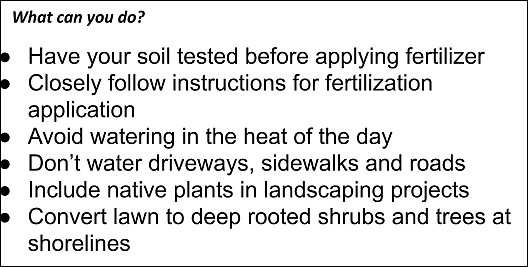Wise lawn, garden care protects our waterways
As our population increases, beloved North Idaho lakes and streams are at heightened risk of pollution. However, homeowners can do a lot to protect and improve water quality through proper lawn and garden care and by landscaping with native or near-native plants that are acclimated to thrive without extra water and/or fertilizers. Soluble nutrients found in fertilizers, nitrogen and phosphorus, are beneficial to yards and gardens. Unfortunately, these nutrients cause problems when they enter lakes, rivers and streams by accelerating aquatic plant and algae growth. This can have a negative impact on waterways where we swim, fish and boat.
Domestic water use in Idaho more than doubles due to outdoor watering during the summer dry season. This is expensive for users and reduces both groundwater availability and critical summer flows to lakes and streams. In addition, even small amounts of overwatering can dramatically increase polluted inflow to our waterways. Wise water use, careful use of fertilizers and good landscape design can help protect our clean water.
When planning your landscaping projects, consider native cousins to common ornamental plants. Many native plants are floral, showy and ideal for residential landscaping. They use less water and fertilizers than non-native varieties. In addition, these plants should be used along waterbodies to provide shade and bank stability. You can learn more about selecting native plants for home landscaping from University of Idaho Kootenai County Extension at uidaho.edu/NativePlants. They also provide resources on efficient lawn care, fruit and vegetable gardening, pest control, pollinators, and more at uidaho.edu/KootenaiGrowing.
Lush green lawns are popular and can increase property value, but they use a lot of water and can increase waterbody pollution. Overwatering can cause pesticides, fertilizers and sediment to runoff to streams and lakes through the storm drain system. An established lawn needs only one to two inches of water per week. Water in early mornings to avoid evaporation and leave grass clippings on the lawn to retain moisture and provide needed nutrients naturally. Make sure sprinklers hit the lawn and not the street or driveways. Native grasses are beautiful and save money by decreasing the need for fertilizer and water.
Proper and precise fertilizer application can also be a money saver and cut down on pollution runoff. Healthy turf grass growing in our region generally does not need additional phosphorus. Soil tests are essential to determine what, if any, fertilizers are necessary. U of I Extension service offers a standard soil fertility test. Visit your county Extension office to pick up a test kit with instructions. You will send the soil sample along with $45 to the U of I soils lab. The results take a couple of weeks, and you will get an in-person consultation of the results with a certified Master Gardener. Do-it-yourself soil test kits from the hardware store are rarely accurate enough to make fertilizing decisions. Be sure to water your lawn sparingly after fertilizing to prevent excess water and fertilizers from running into storm drains and into the lake.
Lawns along streams and lakes or near drainage ways can contribute to an increase in unwanted fertilizer, pesticide and sediment in our surface waters. Instead, consider leaving a buffer of native or beneficial plants, such as shrubs or trees with deep root systems to slow water flow and filter out contaminants as it runs off your property. In Kootenai County, a 25-foot site disturbance setback is required along shorelines. Most experts suggest a larger setback is critical to maintain lake and stream health. For example, the Idaho Forest Practices Act requires a 75-foot stream protection zone or buffer.
Remember, the Our Gem Collaborative LakeASyst program provides homeowners with water-protection checklists, home and yard self-assessment tools, and additional easy-to-read, vital information for making our lake and waterways clean and healthy. Find the LakeASyst manual and other articles in this Our Gem series at uidaho.edu/ourgem.
• • •
The Our Gem Coeur d’Alene Lake Collaborative is a team of professionals working to protect our local water resources. Participating entities include Coeur d’Alene Tribe Lake Management Department, Idaho Department of Environmental Quality, Kootenai Environmental Alliance, CDA 2030, CDA Chamber of Commerce, and University of Idaho Community Water Resource Center.





